Largo Plebiscito merges with Piazza Vittorio Emanuele II, commonly known as ‘il Borgo’ by the local Monopolitans. After the maze of narrow streets of the old town, the spaciousness of the square introduces the new face taken on by the city at the turn of the eighteenth and nineteenth centuries, under the pressure of an increasingly enterprising and industrious bourgeoisie. Positioned to the west, behind the line of the old city wall it serves as a watershed between the old town and the borgo murattiano (The district takes its name from Joachim Murat, who began its construction, during his rule at the head of the Kingdom of Naples) It is almost a perfect square of an area of 22,000 square meters. Around its perimeter is a double row of Hollyoaks planted in 1893
The ‘borgo’ or piazza is formed of two rectangles crossed by a fifteen-metre-wide avenue. Initially, at the end of the eighteenth century, engineers Sorino and De Simone proposed the idea of a portico; however, the cost of the project proved too expensive and therefore, was rejected. On the left as you leave Largo Plebiscito, is a War Memorial which commemorates the towns, 300 victims of World War I., It dates back to 1928 and is the work of Simone di Brindisi. A stop in the Borgo Murattiano allows you to walk around a grid of straight streets while admiring the portals, coats of arms and balconies.
Returning to Largo Plebiscito and heading in the direction of Via San Domenico, you arrive at the church dedicated to the saint of Guzman. Between the 16th and 17th centuries, buildings destroyed by artillery fire in April 1528 at the behest of Andrea Gritti the then commander of the Venetian garrison, were rebuilt behind the city walls to prevent them falling into the hands of the Spanish. As a result, the 14th-century Dominican church of Santa Maria Della Nova was razed to the ground. The subsequent reconstruction of the present-day church of St Dominic features a majestic facade with several elegant and refined frames, carvings and precious sculpted images.
The intricate work of the rose window stands out like a Romanesque echo. In the tympanum stands a sculptural group of the enthroned Madonna with child, a feature from the previous building and one credited to Stefano da Putignano. The eye is naturally guided along the vertical axis to complete the Christological theme with the sculptural groups of the Passion and the Resurrection. Above the rose- window stands the figure of St Dominic giving his blessing, while on the sides of the facade are placed statues of the theological virtues of Fortitude and Temperance.
The interior clearly shows the influence of Leccese baroque from the late sixteenth century in the setting and the decoration. The side chapels were added at the request of local aristocratic families between the sixteenth and seventeenth centuries. Whereas, the magnificent painting, which portrays Saint Peter the martyr by Giovanni Bellini, commissioned for the original church of Santa Maria Della Nova. Now hangs in the Provincial Art Gallery in Bari.
Another important work that was once a feature of the original church now hangs in the diocesan museum and is the Miracle of Soriano by Jacopo Palma the Younger it also highlights the influence of Venice and the Venetians on the Levantine town. Notable features of the chapel of the Rosary by Mauro Manieri are; Our Lady of the Rosary between Saint Dominic and Saint Catherine by Cenatiempo and a pleasant eighteenth-century note introduced by the altars in Neapolitan polychrome marble.
Leaving the church and continuing your journey, you reach the Crypt of the Madonna del Soccorso. Your attention is immediately drawn to the three statues on the entrance door to the hypogeum, preciously carved by the famous Renaissance artist Stefano da Putignano, they depict a boy between two figures in prayer. Without doubt, they came from the church of Santa Maria Della Nova and thus spared from the Spanish army cannons.
Access to the crypt is by a steep staircase that descends six meters below street level. Originally an ancient harbour channel the square vault presents two naves divided by columns and terminating in two apses. Noteworthy is the fresco of the enthroned Madonna with child which dates to the fifteenth century.


















